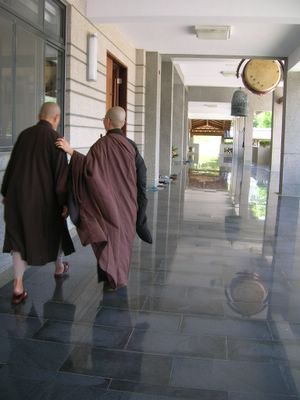John, you ask me what Dharma Relatives are and I realize there may be others who do not know completely what that term means. In the context of this journey to Asia my ‘relatives’ are monks and nuns who share the same religious ancestors. For example, Seck Lee Seng, of Cheng Hoon Teng, where I am at the moment, is my Dharma Aunt by virtue of being the monastic disciple of Seck Kim Seng who also ordained Rev. Jiyu-Kennett into the priesthood back in 1962. They both have the same Master, Seck Kim Seng, who is referred to as my Grand Master and his Master as my Great Grand Master.
After ordination within the Chinese Tradition here in Melaka Rev. Master Jiyu then went on to Japan to be received into the Soto Zen Church to study with and eventually receive Dharma Transmission by Koho Zenji at Sojiji. I thus have two sets of Dharma relatives making my family a very very large one. An interesting part of having this duel Chinese/Japanese background are the different robes used within each tradition.
A note on robes: At present I am wearing the robes used in the Chinese tradition, they are cooler and also I pose fewer questions when I encounter people in temples or on the street. The small kesa for example is worn by Japanese monks but not here in Malaysia, or Taiwan. Explaining the kesa in English takes time and care so explaining it for translation takes even more care, and time. So I decided to wear what everybody else wears here to make life simple and make it easier for people to approach me, I may be a westerner but at least I look like a nun. (I was given Japanese monastic clothing not currently used by us in the Order while in Japan). Each time I receive a new item it is carefully explained to me how to wear it, fold it, put it on take it off etc. etc. and everybody wants me to get it right! What is more there is etiquette about what can be worn ‘outside’ and what is OK within the temple, under certain conditions. Lots to learn. There is even more to say on what I see lay devotees wearing here within the Chinese Tradition however that will have to come in a latter Blogger posting.
We talk about the teachings of Buddhism being ‘transmitted’ from Master to disciple, and the unbroken line of master/disciple connections as the ‘Ancestral Line’. In our tradition particularly, Soto Zen, we emphasis the importance of this line of ancestors. We regard it of paramount importance that what is passed on through the centuries is kept true to the source i.e. we point directly to what Shakyamuni pointed to and encourage others to know what Shakyamuni knew/knows. Well, that may have confused a few of you, hopefully not too much, and maybe also given you a glimpse into how the monastic Sangha is organized. I guess it is obvious that the seniority of monks is based on ordination date and that the basis of keeping harmony in the Sangha is mutual respect, mutual bowing.
So, coming full circle, this journey has been an opportunity to pay my respects to those who have gone before me and to those who travel the path of Buddhism in this Dharma Family now. It has included sites in Japan, Malaysia and China, and living relatives in a number of the countries I have been to. During temple visits as my poor brain staggers to catch up with me I realize, once again, that I am in the presence of yet more Dharma Relative.
Writing all of this makes what I was shown this afternoon in the Seck Kim Seng Memorial Library and Archive all the more interesting. After six hours out in the heat on tour in Melaka with Shih Fu I stumbled into the library on my way to take a short break. To cut a long afternoon of adventure short I believe I have just been shown certificates passed on from Master to Disciple at the time of ordination and transmission dating back to the time my Great Grand Master was authorized to teach by his Master way back in China at a temple called Fu Ching on Kui Shang (Turtle Mountain) in Hokkien Province. I know Iain will be noting down this information and diving for a map! I have come to appreciate maps too Iain!




